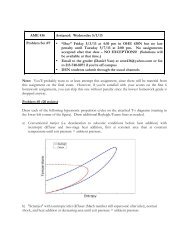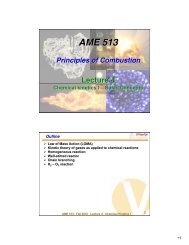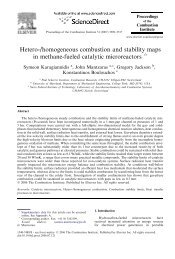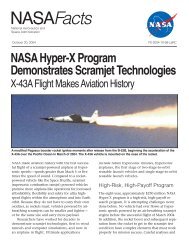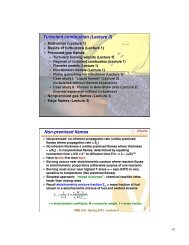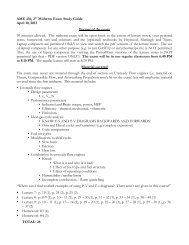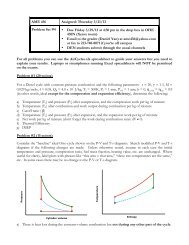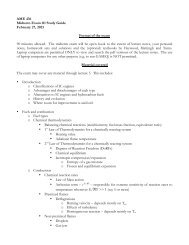AME 436
AME 436
AME 436
Create successful ePaper yourself
Turn your PDF publications into a flip-book with our unique Google optimized e-Paper software.
Effect of heat input (Diesel)"<br />
Animation: P-V diagrams, increasing heat input via increasing f (same<br />
displacement volume, same compression ratio)<br />
Pressure (atm)<br />
8.0<br />
7.0<br />
6.0<br />
5.0<br />
4.0<br />
3.0<br />
2.0<br />
Compression Combustion Expansion<br />
Blowdown Intake Exhaust<br />
Intake start 1 2<br />
3 4 5<br />
6 7<br />
P-V diagram<br />
P-V diagram<br />
(high (low heat input)<br />
(medium heat<br />
1.0<br />
0.0<br />
0.0E+00 1.0E-03 2.0E-03 3.0E-03 4.0E-03 5.0E-03 6.0E-03<br />
Cylinder volume (m^3)<br />
<strong>AME</strong> <strong>436</strong> - Lecture 8 - Spring 2013 - Ideal cycle analysis<br />
33<br />
Effect of heat input (Diesel)"<br />
Animation: T-s diagrams, increasing heat input via increasing f (same<br />
displacement volume, same compression ratio)<br />
Heat input does affect efficiency (shrinking T L /T H in Carnot strips as f<br />
increases)<br />
800<br />
Compression Combustion Expansion<br />
Blowdown Intake Exhaust<br />
Close T-s cycle 1 2<br />
3 4 5<br />
6 7<br />
700<br />
Temperature (K)<br />
600<br />
500<br />
400<br />
300<br />
200<br />
T-s diagram<br />
(medium (high (low heat heat input)<br />
100<br />
0<br />
-100 0 100 200 300 400 500 600 700<br />
Entropy (J/kg-K)<br />
<strong>AME</strong> <strong>436</strong> - Lecture 8 - Spring 2013 - Ideal cycle analysis<br />
34<br />
• 17





